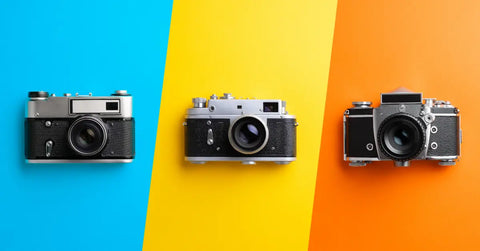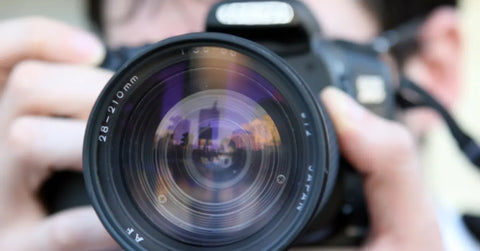Have you ever stared at a photo and felt a bit disoriented but totally intrigued by just a mix of shapes, colors, and textures, kind of like a visual puzzle? That's the magic of abstract photography!
It’s this cool, artsy genre where the usual rules of photography don’t apply. Instead of showing you a picture-perfect landscape or a crisp portrait, abstract photography plays with your senses and emotions.
It strips away context and invites you to come up with your own story about what you’re seeing. It’s not just about snapping what things look like; it’s about capturing how they feel.
In this blog, we’re going to dive deep into the wild world of abstract photography. We’ll check out different techniques, take a quick tour through its history, and see how it turns simple visuals into complex emotions.
So, if you’re ready to see beyond the obvious and explore some truly unique perspectives, stick around! We’re about to shift our focus from the straightforward to the spectacularly abstract.
What Is Abstract Photography?
The Essence of Abstraction in Photography

Abstract photography is all about breaking down scenes and subjects into their core components—think of it as playing with the building blocks of light, texture, color, and shape.
Instead of showing you a picture that screams, "Hey, this is exactly what I am!" this style kind of nudges you to see things differently.
It’s less about capturing a flower in full bloom and more about highlighting the swirl of colors or the dance of shadows and light that you might miss in a more straightforward snapshot.
The magic of abstract photography lies in its ability to make you feel something, think a bit deeper, or fire up your imagination. It’s not just about what’s in the photo; it’s about what you see and feel when you look at it.
Maybe a swirl of blue and green isn't just a swirl—it could be an ocean wave or a close-up of a peacock feather. The fun part? It’s all up to what you think and feel when you see it.
Historical Context and Evolution

Abstract photography really kicked off in the early 20th century, a time when some bold photographers decided to start bending the rules. They began playing around with close-ups, capturing tiny details, and using funky angles that made everyday scenes look totally unexpected and new.
These early adventurers in photography, like Man Ray and Alfred Stieglitz, weren’t just taking pictures; they were more like magicians with their cameras.
They experimented with how light and shadow fell across their subjects, tweaked how they focused their lenses, and even messed around with the developing processes to create pictures that were less about capturing a perfect replica of the world and more about creating a feeling or a mood.
These guys weren’t interested in just showing things as they are. They wanted to explore and share their personal interpretations of the world around them.
By manipulating their photographic tools and techniques, they invited everyone to look at the world in a new way, sparking imaginations and opening up a whole new realm of artistic expression in photography.
Techniques Used in Abstract Photography
When diving into abstract photography, photographers really let their creativity run wild with a bunch of cool techniques.
Each of these techniques adds its own special twist to images, transforming ordinary scenes into something truly unexpected. Here’s a rundown of some popular methods:
Macro Photography

Ever notice the tiny details on the surface of a bubble or the intricate patterns of a leaf? Macro photography zooms in on these usually overlooked details, magnifying them to fill the whole frame. This can turn a simple texture or color into a striking feature that feels completely new and different.
Intentional Camera Movement (ICM)

Instead of keeping the camera steady, try moving it around while you snap a photo. This intentional shake isn’t about blurry mistakes; it’s about creating a smooth, painterly effect that captures motion in a still image.
It’s like using your camera to paint with light and shadow, giving you some truly funky results.
Multiple Exposures

This is where you layer two or more exposures on top of each other in a single image. It’s a bit like double vision, where each layer adds depth and complexity to the scene, creating a surreal and dreamy effect that can be super mesmerizing.
Light Painting

Grab a flashlight or any handheld light source, and you can literally draw in the air with light during a long exposure. This technique lets you highlight specific areas of your scene, or add wild streaks of light that seem to dance around your subject. It’s a fun way to add dramatic or whimsical elements directly into your photographs.
Each of these techniques invites you to break the rules of traditional photography to find your own unique style. They open up endless possibilities for experimentation, so you can keep playing until you find what clicks for you in the abstract world.
Whether you’re zooming in close, shaking things up, layering images, or painting with light, there’s no limit to the abstract art you can create with your camera.
Notable Abstract Photographers to Follow
Look into the world of abstract photography by checking out some stars of the scene—Edward Weston, Aaron Siskind, and Wolfgang Tillmans. These guys are not just photographers; they’re like wizards with a camera, turning the ordinary into extraordinary abstract masterpieces.
Edward Weston was known for his genius in transforming natural forms, nude bodies, and landscapes into visually stunning abstracts. His work makes you think about the beauty and complexity of simple shapes and forms.
Aaron Siskind took a different approach. He focused on the details of the world that most of us overlook. His photos often zoom in on the textures of peeling paint or crumpled paper, turning them into canvases of abstract art.
It’s like he shows us how there’s a whole universe in the smallest details.
Then there’s Wolfgang Tillmans, who blends the contemporary with the abstract. His work is super diverse, ranging from stark still lifes to fluid, almost dream-like images that challenge our perceptions of space and form.
By exploring their work, you can really open your mind to what abstract photography can be. It’s all about breaking the rules, playing with perspectives, and seeing the world through a lens that turns the mundane into something magical.
So, grab your camera and let their creativity inspire you to find your own abstract vision!
Conclusion
Abstract photography is more than just a photographic discipline; it is a method of seeing the world through a different lens, literally and metaphorically. It challenges photographers to explore and express themselves and viewers to engage and interpret.
As we've explored the what, why, and how of abstract photography, it's clear that this genre holds a unique place in the visual arts, offering endless possibilities for creativity and personal expression.
If you're intrigued by the world of abstract photography, grab your camera and start experimenting. Look beyond the obvious, focus on details, and let your creative instincts guide you. Remember, in abstract photography, there are no rules—only infinite possibilities.
Ready to start your abstract photography journey?
Share your thoughts and experiences in the comments below or on social media. Let's keep the conversation about visual art vibrant and evolving!
Visit Nuzira and join our Discord channel to learn more about Abstract Photography!






